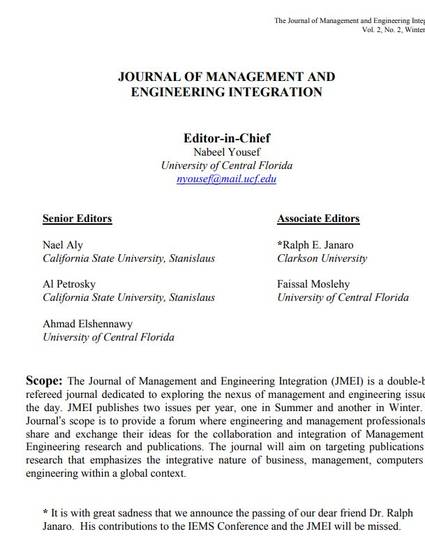
Article
Operating Performance Comparisons between Laser Doppler Velocimetry and Time of Flight Techniques
Journal of Management & Engineering Integration
(2009)
Abstract
Characterizing the aerodynamic diameter of aerosol particles in the atmosphere or generated from the respiratory drug delivery devices has been subject of research for a long time. This study presents the operating performance comparisons between two aerosol particle sizing instruments which incorporate real time characterization of both atmospheric and respiratory drug aerosols. The instruments were: the single particle aerodynamic relaxation time (ESPART) analyzer and the aerodynamic particle sizer (APS) spectrometer. The ESPART operates on the principle of laser-dopplervelocimetry, whereas the APS operates on the principle of time-of-flight technique. They are a class of instruments that measure the aerodynamic diameter of individual particles following a controlled acceleration in a welldefined flow field. Both instruments are capable of sizing several thousand particles in a second. The tested aerosols were generated from several commercially available respiratory drug delivery inhalers, nebulizers, and blow-off cup aerosol generators. They were 1) Qvar Metered Dose Inhaler (MDI), 2) Albuterol MDI, 3) Ventolín MDI, 4) PARI-LC Plus Nebulizer and NaCl solution (7mg/ml), 5) PARI-LC Plus Nebulizer and Polymer Microsphere solution in water, 6) Blow-off cup and Lactose Monohydrate submicronized powder, and 7) Blow-off cup and Mannitol powder. The results showed that both instruments demonstrated similar performance within ± 0.5% variation for the aerosols with count median aerodynamic diameter (CMAD) > 3.0 µ?? and mass median aerodynamic diameter (MMAD) > 4.0 µ??. However, both instruments showed some different performances within ± 4% variation for the aerosols with CMAD and MMAD less than 3.0 µ?? and 4.0 µ?t, respectively. The ESPART was providing electrical charge and polarity of aerosols in addition to particle's aerodynamic diameter information.
Keywords
- Operating Performance,
- Laser Doppler Velocimetry,
- Time of Flight Techniques
Disciplines
Publication Date
Winter 2009
Citation Information
Mohammed Ali. "Operating Performance Comparisons between Laser Doppler Velocimetry and Time of Flight Techniques" Journal of Management & Engineering Integration Vol. 2 Iss. 2 (2009) p. 1 - 13 Available at: http://works.bepress.com/mohammedali/12/
